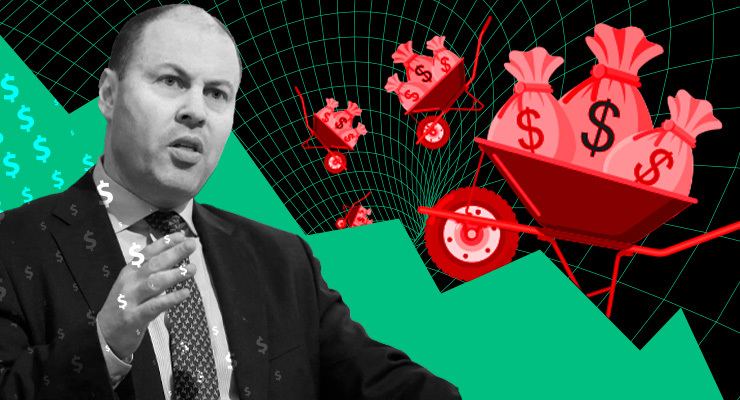
The Morrison government is counting on the private sector and cashed-up workers to drive a surge of economic growth, fuelled by a half-trillion dollar deficit binge that the government believes will return unemployment to 2019 levels by 2024.
In tonight’s budget for 2020-21, Treasurer Josh Frydenberg has unveiled not merely a record deficit of $213.7 billion for the current year, but a series of astonishing deficits stretching into the mid-2020s: a monster $112 billion in 2021-22, $88 billion in 2022-23 and $68 billion in 2023-24.
The bill for taxpayers will be nearly half a trillion dollars, driving government net debt to nearly $1 trillion by 2023-24, or over 40% of GDP, and leaving government spending still at historic levels years from now.
However the beneficiaries of the largesse will not be those most likely to spend it, or who need it the most, but middle- and high-income earners and business, whom the government hopes will spend up big to push economic growth above 4% next financial year and get unemployment back down below 6% by mid-decade.
Between the stage two tax cuts, brought forward to this financial year, and a 100% investment write-off for all but the very largest businesses, taxpayers will fork out nearly $45 billion over four years in the two biggest ticket items in a budget filled with unprecedented numbers.
But low-income earners and the unemployed receive little: low-income earners will get only half the tax cut that middle- and high-income earners receive, while the unemployed still face a New Year nightmare as JobSeeker payments revert to their below-poverty pre-COVID level at the end of the year.
The residential aged care sector has received some extra funding but not the crucial expansion in support it needs: the government has poured extra money into its under-pressure Home Care program, spending $1.6 billion on 23,000 more places, another $205 million to try to retain aged care workers in the sector and some extra funding for the beleaguered Aged Care Quality and Safety Commission. But residential care will continue under existing funding arrangements, with only some one-off COVID-related payments for assistance for providers.
Social housing investment — urged on the government by virtually every stakeholder for months — is also absent. The government’s increase in infrastructure spending — notionally $9 billion, although the area is particularly subject to the government’s penchant for re-announcements — also lacks the kind of big-bang commitment that many were calling for to support the economy.
Instead, the government is hoping that bringing forward tax cuts for middle- and high-income earners will get Australians spending, in turn encouraging business to take advantage of generous tax incentives (including an ability to retrospectively claim back current losses, creating a tax rebate) and start investing and employing.
It’s not quite trickle-down economics, but it’s a massive, debt-fuelled Keynesian investment in animal spirits intended to lift a struggling economy somewhere back to where it was before the pandemic hit.
If it ever does, we’ll still have a national debt that will take decades to pay off.








Image the good they could do with a permanent rise to a living wage for the unemployed and low income earners. Not just ethically, but economically.
I guess that’s a moot point, as ideological blindness trumps all.( No pun intended).
The whole budget reads as lipstick on a pig to try and hide a core of trickle down economic policies. There is definitely some Keynesian thinking in there, but it’s lacking that fundamental support for the actual drivers of the economy.
Any who, I’m sure Frydenburg will be lauded as a genius for this budget despite it being painfully generic.
When was the last time the GDP growth rate was 4% or above?
As best I can find, it was in the mid 1970s. And the highest ever was 4.4%.
Hard to see that handing money to people who already have money to spare will cause in increase in consumption.
Also, when Rudd and Swann spent big, we ended up with some tangible assets at the end.
This splurge, it seems, will not give much of anything.
Why are they cutting milliions from homeless programs, while at the same time reducing JobKeeper and JobSeeker? It is like they are trying to create more of an underclass.
Foodbanks are already struggling. What do they think will happen when the banks start to demand payment on mortgages?